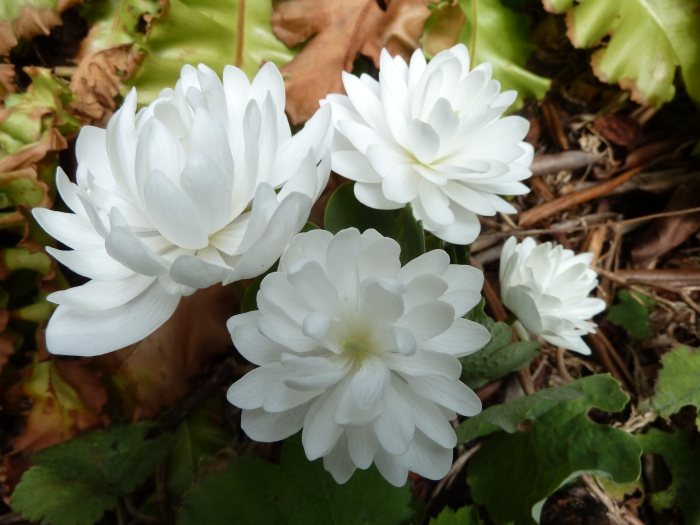Bloodroot
(Sanguinaria canadensis)
Bloodroot (Sanguinaria canadensis)
/
/

Brunk-Tan
CC BY-SA 4.0
Image By:
Brunk-Tan
Recorded By:
Copyright:
CC BY-SA 4.0
Copyright Notice:
Photo by: Brunk-Tan | License Type: CC BY-SA 4.0 | License URL: https://creativecommons.org/licenses/by-sa/4.0 | Uploader: Brunk-Tan | Publisher: Wikimedia Commons | Title: Sanguinaria_canadensis_Multiplex.jpg | Notes: Transferred from Flickr via [[Commons:Flickr2Commons|Flickr2Commons]] |














































































Estimated Native Range
Summary
Sanguinaria canadensis, commonly known as Bloodroot, is a deciduous perennial herb native to deciduous woodlands of eastern North America, including the Eastern USA and Southeast Canada. It is also known by other names such as Canada puccoon, bloodwort, redroot, and red puccoon. Bloodroot exhibits significant variability in leaf and flower morphology, which has led to the recognition of different subspecies within the species. It typically grows from 20 to 50 cm (8 to 20 in) tall. The distinctive red-orange sap of the rhizome gives rise to the common name and the genus name Sanguinaria, from Latin sanguinarius meaning "bloody". The rhizomes extend and branch over time, forming clonal colonies. Bloodroot blooms before the foliage fully expands in early spring, with a flowering period from March to May, varying by region and weather conditions. The flowers, which open in direct sunlight and close at night, are pollinated by small bees and flies.
Bloodroot is valued for its early spring blooms and is often used in woodland gardens and shade gardens for its naturalizing tendencies. The ephemeral flowers, typically white, are short-lived, lasting only a day or two after pollination, but the double-flowered cultivars offer a prolonged display. These double flowers, with stamens transformed into petal-like structures, are particularly showy but less accessible to pollinators. In cultivation, Bloodroot prefers part shade to full shade, medium moisture levels, and well-drained soils. It is a low-maintenance plant that goes dormant in mid to late summer. However, gardeners should be aware that the sap can be a skin irritant and that the plant is toxic if ingested.CC BY-SA 4.0
Bloodroot is valued for its early spring blooms and is often used in woodland gardens and shade gardens for its naturalizing tendencies. The ephemeral flowers, typically white, are short-lived, lasting only a day or two after pollination, but the double-flowered cultivars offer a prolonged display. These double flowers, with stamens transformed into petal-like structures, are particularly showy but less accessible to pollinators. In cultivation, Bloodroot prefers part shade to full shade, medium moisture levels, and well-drained soils. It is a low-maintenance plant that goes dormant in mid to late summer. However, gardeners should be aware that the sap can be a skin irritant and that the plant is toxic if ingested.CC BY-SA 4.0
Plant Description
- Plant Type: Herb
- Height: 0.5-0.8 feet
- Width: 0.3-0.5 feet
- Growth Rate: Slow
- Flower Color: White
- Flowering Season: Spring
- Leaf Retention: Deciduous
Growth Requirements
- Sun: Part Shade, Full Shade
- Water: Medium
- Drainage: Slow, Medium
Common Uses
Bee Garden, Bird Garden, Butterfly Garden, Deer Resistant, Drought Tolerant, Rock Garden, Showy Flowers, Water Garden
Natural Habitat
Native to deciduous woodlands of eastern North America
Other Names
Common Names: Canadian Puccoon, Red Puccoon, Redroot, Black Paste, Tetterwort, Bloodwort, Puccoon-Root, Sang-Dragon, Sanguinaire, Sanguinaire Du Canada, Blodört
Scientific Names: , Sanguinaria canadensis, Sanguinaria canadensis f. multiplex, Sanguinaria canadensis var. rotundifolia, Sanguinaria rotundifolia, Sanguinaria canadensis var. canadensis, Sanguinaria canadensis var. multiplex, Sanguinaria mesochora, Sanguinaria australis, Belharnosia canadensis
GBIF Accepted Name: Sanguinaria canadensis L.